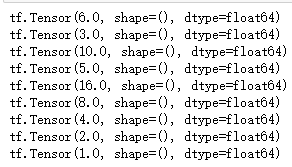一、即时执行模式
import tensorflow as tf
import tensorflow.contrib.eager as tfe
tfe.enable_eager_execution()
a = tf.constant(12)
counter = 0
while not tf.equal(a, 1):
if tf.equal(a % 2, 0):
a = a / 2
else:
a = 3 * a + 1
print(a)

二、用Eager执行模式的MNIST模型构建
import tensorflow as tf
import tensorflow.contrib.eager as tfe
tfe.enable_eager_execution()
from tensorflow.examples.tutorials.mnist import input_data
class MNIST:
def __init__(self):
self.mnist = input_data.read_data_sets("data/MNIST_data/", one_hot=True)
self.train_ds = tf.data.Dataset.from_tensor_slices((self.mnist.train.images, self.mnist.train.labels))
.map(lambda x, y: (x, tf.cast(y,tf.float32))).shuffle(buffer_size=1000).batch(100)
self.W = tf.get_variable(name="W", shape=(784, 10)
self.b = tf.get_variable(name="b", shape=(10, ))
def softmax_model(self,image_batch):
model_output = tf.nn.softmax(tf.matmul(image_batch, self.W) + self.b)
return model_output
def cross_entropy(self, model_output,label_batch):
loss = tf.reduce_mean(tf.reduce_sum(label_batch * tf.log(model_output), axis=[1]))
return loss
@tfe.implicit_value_and_gradients
def cal_gradient(self, image_batch, label_batch):
return self.cross_entropy(self.softmax_model(image_batch), label_batch)
def train(self):
optimizer = tf.train.GradientDescentOptimizer(0.5)
for step, (image_batch, label_batch) in enumerate(tfe.Iterator(self.train_ds)):
loss, grads_and_vars = self.cal_gradient(image_batch, label_batch)
optimizer.apply_gradients(grads_and_vars)
print("step: { } loss: { }".format(step, loss.numpy()))
def evaluate(self):
model_test_output = self.softmax_model(self.mnist.test.images)
model_test_label = self.mnist.test.labels
correct_prediction = tf.equal(tf.argmax(model_test_output, 1), tf.argmax(model_test_label, 1))
self.accuracy = tf.reduce_mean(tf.cast(correct_prediction, tf.float32))
print("test accuracy = { }".format(self.accuracy.numpy()))
if __name__ == '__main__':
mnist_model = MNIST()
mnist_model.train()
mnist_model.evaluate()